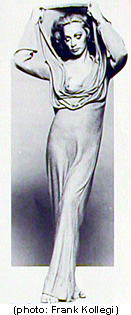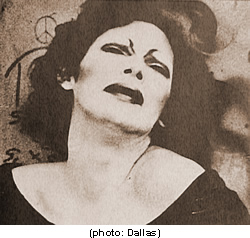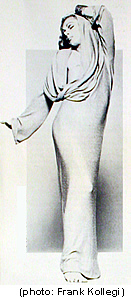The following article first appeared in the October 1982 issue of Stallion - "The Magazine of the Alternate Lifestyle"
The Madness of Making a Movie with Holly Woodlawn
by Dallas
BROKEN GODDESS was first screened at Joseph Papp's New York Shakespeare Theatre in its Anthology Film Archives, which up to that time screened only recognized film classics. It was next shown for three performances at the New York Cultural Centre. It then became the first film short in history to open commercially as the head of a double bill, which included the lost silent classic, SALOME, starring Alla Nazimova, at the Playboy Theatre.
-----
With my first acid trip, my lifelong aspirations for movie stardom went up in smoke. I was eighteen, and while the rest of America's youth dropped out of universities, I dropped out of my acting class at the Herbert Bergof Studio. (An acting class at HB is like the clap - everyone in New York's had it.) Since that time I have wanted only one thing, professionally, and that has been to direct great motion pictures.
There are, I soon discovered, easier things to want.
Being a movie director seems to be the American equivalent of being King. No one is quite sure how to become one, but everybody tries. There are schools which purport to teach directing, but I do not trust them (as I would not trust a school which purported to graduate kings). Instinct, timing, and vision cannot be taught, no matter how high the tuition fees. One sure way to become a movie director, however, is to pick up a movie camera and direct. This costs. But since I was fortunate enough to have made a small bundle lighting and staging for some of the bigger names in the record business, at the ripe old age of twenty-one, I packed my lighting gels away and picked up a movie camera to direct Broken Goddess, a film destined to become an underground classic.
That was 1973.

Broken Goddess is a revival of silent cinema - silent in that there are no spoken words; rather the story is told in title cards drawn from the lyrics of Laura Nyro's songs against a soundtrack of Debussy's music. The project was conceived around a then-fledgling starlet named Better Midler. And it would have worked. But one night while I was photographing Tally Brown's act at the Continental Baths, a strange thing happened. Tally introduced me to her then co-star in a film Scarecrow in a Garden of Cuncumbers (which willl be forever remembered if only for the fact that its title song was performed by Bette Midler and there was a fleeting cameo by Lily Tomlin as a telphone operator) - one Holly Woodlawn.
La Woodlawn, you will remember, was riding high on the smashing success of Warhol's Trash [directed by Paul Morrissey] and an unprecendented write-in ballot to secure this new film personality an Oscar nomination. We had all seen that bizarre snaggled-toothed creature's poignant performance. And when the thundering applause that night subsided, the number one Warhol star of then and now rose in the presence of a shy, curly haired boy in farmer overalls. I, like everyone else present that night, was floored.
The flash was instant. I would turn Holly Woodlawn into a silent film siren - the new Gloria Swanson/Theda Bara.
Holly loved the idea - took to it, in fact, like a heroin addict to methadone. And since Bette was squeamish even then over the prospect of making a whole decision, Holly and I began work several days later.
Why, some people asked, a silent movie? Having had no education beyond New York City public high school (and that counts for nothing), I figured the best place to start directing great motion pictures was at the beginning. And move forward from there. Nice and simple; a one-character one-reeler. That's where D.W. Griffith started. And Mack Sennett. and Charlie Chaplin.
Since there would be no dialogue, the face had to say it all. So we began with The Look. I picked up a shredded black crepe gown from under a pile of junk in Holly's closet and said "wear this." I called the best make-up artist in New York, Vincent Nasso, who hooked his fingers to my brain and started painting. And plucking. And shaving.

We called it Western Kabuki; a face like a mask that encompassed all the elements we were after - Greek tragedy, pop art, and silent cinema. Vincent treated Holly's face like so much canvas, layering make-up on make-up, until just the right mask was attained.
With a crew of six men we shot the entire film in a series of twelve mornings (from 4 a.m. to 7 a.m.) that spanned two months at Bethesda Fountain in Central Park. Void of the crowds, the fountain was the perfect silent movie set. And the early morning light made Holly Woodlawn appear to be made of the same pale marble as the surrounding set.
Things did not run smoothly.
Holly was a drunk at the time (I can say this now because, if anything, Holly is today a reformed drunk). She was used to different modes of behavior, different styles of acting, different hours. Holly was a raw talent - fascinating, original, but totally undisciplined. The Woodlawn persona could be brilliant one moment but unable to recreate or even recollect it the next. Part of it was the lack of experience; part of it, the booze; part of it was my lack of experience; and part of it was simply that I was asking something different of Holly than had been required of her in thouse Warhol/Morrissey productions, movies which sought to capture what already existed. I was trying to create something that did not. We were like the blind leading the blind.
Since the make-up took three hours to apply, Vincent would arrive at my apartment, which had now become a movie studio, and looked increasingly like a bomb shelter (Holly and a collection of feather boas having since moved in), at 1 a.m. to start painting. Sometimes Holly was awake. Sometimes Holly was passed out from drink. Sometimes there was no Holly at all, and we'd have to spend all night scouting gay bars. Sometimes Holly would be ready and willing, and Vincent unable to show. He was, after all, expected to keep up with his paying clients. And sometimes, we'd all make it and spend the night getting ready, schlepp to the fountain just before dawn, set up the cameras and it would start pouring. Other mornings, it was too sunny (the light had to match). One horrifying morning, near the end of production, we arrived to find an entire restaurant spread out across our "set." The annual Fountain Cafe was preparing to open. Did David O. Selznick ever have it so bad?

The sustaining factor throughout was Holly Woodlawn: Holly's response, Holly's natural talent (drunk or sober), Holly's charisma, Holly's incredible ability to come alive in front of a lens. Holly was the one professional around whom all these first-time movie makers were pouring forth their talents. Holly Woodlawn was, as always the catalyst.
Holly's generosity knew no bounds. Aware of the lack of funding, but swept into the spirit of the film, the agreed-upon front money for this staggering performance was a mere bottle of wine (there was, of course, a hefty percentage of the gross forthcoming). Holly gave 100%, asking in return only a little Gallo port. One particular morning, when my generosity knew no bounds, I had gotten a gallon jug. This was a fatal error; for while we busily set up the tripods, and checked the light meters, the gallon jug was being single-handedly emptied by a rather well-spirited silent film siren awaiting her cue.
I was later accused of uncommon cruelty when I forced Holly, under the threat of death, to perform the scene anyway. I mean, hell, we'd been up all night preparing, and the sky was just right. Drunkenness was not going to stand in the way! We restructured the shoot to contain only moments when the body was seated or lying down, since walking was out of the question. (Is that what Billy Wilder meant when he referred to "shooting around Marilyn"?)
Things took longer than usual that morning, so it was about 8:30 when we finally traipsed back to my apartment building, and this magnificently painted "woman" was led, by the elbows through the lobby and into the elevator. We thought we were finally safe, when the elevator door opened and several of my neighbors, still with sleep in their eyes, got in on their way to work. On yet another floor, a woman entered obviously taking her three children to school. It was cramped quarters while people tried not to notice that this heavily painted woman was dead drunk, barefoot, and in a black gown that looked like it had been put through a blender.
People smiled a lot, if you know what I mean. It's something people do in the forced intimacy of a New York elevator. And then, between floors four and five Holly's legs gave way, and before anyone knew what had happened, La Woodlawn, with eighteen pounds of panstick and eyeliner, lay strewn at our feet, legs spread, gown torn a little more than it should, exposing a neat little bundle where a boy's bundle is to be found. I ask that you use your own imaginations here to picture the expressions on my neighbor's faces - for mere words on paper could only diminish the confusion and disbelief that resulted. It seemed two years before the elevator door opened and we casually sashayed out.
Welcome to Hollywood! So this is what directing movies is all about...
We made it through that and many more ordeals before the movie was finally "a wrap," and I was drained of every cent and twenty-four pounds lighter than than I was supposed to be. I had a lot of footage but no idea how a movie would eventually be made of it. I now learned the invaluable role a film editor plays. Erik Boer was (and still is) a top Zoli model. On the side, he happened to be one of New York's more talented film editors. He liked the footage enough to join our merry band of gypsies, for we were like a vagabond road company, traveling mistrels, mad scientists. He even consented to work, like the rest for free. But, he told me, it would cost about $7,000 more to turn the footage into a movie. I was already living on borrowed money and borrowed time. The situation seemed hopeless. Fade out.
Fade in: Interview magazine hit the stands. Between the covers was a story called "D.W. Dallas," touting the film and its creator. Warhol's magazine called Broken Goddess "a parade of living sculpture, a magnificent time-piece that shows Holly Woodlawn off to new advantage." They went on to say that the film was "stunningly directed by a new cinematic eye." Then someone at the Factory said Sam Goldwyn; another Orson Welles. I was off and running (precisely to where I have yet to decipher, but I am still running). The talk had begun. But talk, I soon learned, is cheap.
If necessity is the mother of invention, then Holly Woodlawn is the Goddess of Resourcefulness. With the enthusiasm of both Mickey Rooney and Judy Garland, Holly exclaimed, "We'll have a screening!" My apartment/movie studio/bomb shelter now became a movie palace, where the rich and the famous were invited to exclusive "advance" screenings of this new trendy underground film. We showed loose footage to anyone with a buck, while I juggled Debussy records on the stereo. And what started out as an MGM barnyard musical deteriorated rapidly into a black and white documentary on unsubsidized talent in America. Nowehere could investors be found.
Life with Holly Woodlawn was like a Norman Lear sitcom. The reality of daily living with this transvestite Superstar was like dancing the tango between Mary Hartman and Maude. To complicate matters further, we were becoming destitute.
Actually, things weren't too bad. When we pooled our assets, we found we could live, however modestly, in the two-figure bracket. It was instant mashed potatoes and a can of beer while we waited for our ship to come in.
Several screenings later, we were left with little more than a houseful of ashtrays steeped with half-smoked butts. I tried to find work, but there were no openings for a young, spirited movie director. (Holly tried, too. But, believe it or not, there wasn't a single call for a silent movie goddess.)
One morning while flicking a chipped red fingernail through the ashtrays looking for for anything worth lighting, Holly said, "Dallas, we're out of butts. Time for another screening."
As I picked up the dead receiver, I astutely realized that the ultimate affront had befallen us. There is no life in New York without a telephone. Where was Lillly Tomlin when we needed her? No phone? No screenings. No screenings? No cigarette butts.
Again, Holly had a plan: Picking up "our issue of Interview magazine, he said, "Darling, now that we're stars, we'll hit the party circuit. In this town there's a party every night. Free booze, hors d'oeuvres, and all the cigarettes we can smoke!"
Keenly aware that in the shallow, superficial, wonderful world of Show Business, appearances mattered, we dressed to the nines - I in my one good suit, Holly in a sequined sheathe and a $12,000 red fox by Ben Khan (on loan). Our hosts, who included Salvador Dali, Halston, and Roberta Flack, had no idea of the life-and-death calculations we were making while shaking hands with our fellow guests. Holly whispered in my ear, "There are nine million stories in the naked city. One of them wants to back a silent movie!"
Several hundred parties later - the mere sight of brie enough to make us sick - the movie was miraculously financed. We rented a cutting room, made the mag tracks and a work print, and sweated it out. Now, I learned how creative the cutting room is. Pictures are literally made or ruined in the editing. The harder we worked, the more excited we became, and the more excited we became, the bigger the film's possibilities. And the bigger the film's possiblities, the more money was need to realize them.
We were now aflame with ourselves. And able to seduce others. More magazine pieces appeared. We took them to Norm Witlen, an opticals man who had done the special effects for Cleopatra. We showed him a rough cut of Goddess, and he consented to do the special effects at cost - from Liz Taylor to Holly Woodlawn. Next, we found an old timer who used to cut negatives at Fox (by matching them against the work print). He had cut two Gloria Swanson movies, and all of the Shirley Temple epics. Louis Somerstain, swept into the spirit of silent cinema revival, now found himself matching the negatives of Holly Woodlawn.
The film was ready at last. It first saw the light of a projector at Joseph Papp's New york Shakespeare Theatre on Lafayette Street. It was greeted with cheers and a standing ovation. Next came three nights at Huntington Hartford's New York Cultural Center, and then a special screeing held in the Grand ballroom of the St. Regis Hotel hosted by our friend Salvador Dali. We were ready for the publique general; that's what Liza says PG stands for.
The critics greeted Broken Goddess with equal enthusiasm. The Daily News called it "a dramatic tour de force." Women's Wear Daily wrote that "the film is beautifully directed and edited and suffused with a certain grandeur that is hard to come by these days." After Dark wrote that we had "triumphantly broken new ground." And Film Comment cited that "La Woodlawn's performance is a blazing thing - all silver trumpets; a highly stylized expose of glamour-as-terror." The New Hampshire Press (still don't know how they got there) called it "a true masterpiece of insight." Ms. said it was "poignant movie making," and Playboy said simply, "we're speechless."
The film was an artistic triumph. Roughly translated, that means it didn't make a dime. But there were scads of publicity, interviews, and more brie. So fuck art, I thought. It was time to make money.
Talkies, I had heard would be the next big thing in movies. So I sat down to write one. A year in the making, my all-female comedy was finally ready for the marketplace. "All female comedy?" the studios said. "You're crazy. We're looking for male properties." (This was 1975. Buddy pictures were the big thing: Steve McQueen and Dustin Hoffman; Paul Newman and Robert Redford; Al Pacino and Gene Hackman.)
If I was ready for Hollywood, Hollywood sure wasn't ready for me. So I tended bar, wrote for magazines, painted silks for Halston.
Holly went on to become one of the top names in cabaret. (That kid will survive anything.) We have this private joke that when the atomic bomb drops - and all of us with it - Holly will kick in the glass window of a liquor store, break open a bottle of Jack Daniels, and toast the future. Holly has survived drug addiction, being hit by lightning (honest), the welfare system, underground stardom, alcoholism, imprisonment in both the Women's House of Detention and Men's, and, probably worst of all, oblivion. All in the space of ten chock-full-of-nuts years. By all rights Holly Woodlawn should be dead - or at least forgotten like the rest of Warhol's "Superstars." Warhol himself once said, "In the future, everyone will be famous for fifteen minutes." Woodlawn's fifteen minutes were up years ago.